This is the Best Herb Butter Turkey. It has classic flavors like sage and thyme, along with a generous amount of sea salt and lemon zest. The lemon herb compound butter is rubbed over and under the turkey skin and roast on a bed of carrots, onions, and celery for an incredibly flavorful and moist turkey dinner.
Thanksgiving will be here before you know it, and if you’re anything like me, you are already getting your holiday menu prepared! I love the classic dishes that come with Thanksgiving. And in our house, Roast Turkey with Garlic and Herb Compound Butter is one of the best parts of the meal.
Preparing a juicy and flavorful turkey is the centerpiece of many holiday meals. While there are many ways to season and prepare your turkey, one of the best tricks is to put flavorful ingredients under the skin. Here’s a guide to everything you need to know about what to put under turkey skin to take your bird to the next level.
Why Put Ingredients Under Turkey Skin?
Sliding butter, herbs citrus and other flavorful items under the skin allows them to permeate the meat during cooking. The skin holds them snugly against the breast and thighs helping transfer their flavors directly to the meat.
Leaving the skin on while cooking also keeps the turkey moist and tender. The fat renders as the bird cooks, basting it from the inside. A seasoned butter boosts flavor even more.
Herb Butter
Herb butter is a popular choice for putting under turkey skin. Combining butter with fresh herbs, garlic, citrus zest and other spices gives you a flavorful compound butter.
When making herb butter
-
Use room temperature, softened butter. This allows it to spread evenly.
-
Chop herbs, garlic, shallots and other ingredients finely before mixing in.
-
Season generously with salt and pepper.
-
Mix in any citrus zest or juices. Lemon, lime, orange all pair well with herbs.
-
For the best flavor, make it the day ahead. This allows time for the flavors to meld.
Popular herb butter combos include:
- Thyme, sage, rosemary
- Tarragon, parsley, chives
- Basil, oregano, garlic
- Cilantro, lime zest, cumin
Spread herb butter evenly under the skin before roasting. As the turkey cooks, the butter bastes the meat from inside the skin. This gives you ultra moist, seasoned turkey meat.
Citrus and Spices
Wedges of lemon, lime, orange or other citrus can be placed under the skin along with herb butter. As the turkey roasts, the citrus infuses it with bright flavor.
Spices like garlic, shallots, ginger, peppercorns, allspice and more can be mixed into the herb butter or placed under the skin whole. Their flavors impart into the turkey as it cooks.
Aromatics
Placing aromatic vegetables inside the turkey cavity or under the skin adds moisture and flavor, Common choices are:
- Onion
- Celery
- Carrot
- Fennel
- Apple
- Orange
- Lemon
Chop the vegetables and herbs into large chunks before placing under the skin. Or simply stuff whole cloves of garlic or shallots under there.
During roasting the aromatics release their moisture and flavor into the meat. Feel free to also stuff them into the body and neck cavities for even more flavor.
Compound Butters
Herb butter is one type of flavored, or compound butter, that can go under the turkey skin. Other compound butter possibilities include:
- Honey butter
- Maple butter
- Chili butter
- Lemon-parsley butter
- Cinnamon butter
- Orange or cranberry butter
Flavored butters add taste and moisture to the turkey meat during roasting. And they can often be made with ingredients you already have on hand.
Oils and Fats
Butter and oil offer options for moisture and flavor under the skin. Olive oil, avocado oil, walnut oil, bacon fat or duck fat add richness. Use them alone or combine with citrus, herbs and spices.
Melted butter also makes a great baste to brush over the skin halfway through cooking. Basting helps further brown and crisp the skin.
How to Get Ingredients Under Turkey Skin
Getting seasoned items under the skin is easier than you may think:
-
Carefully loosen the skin from the breast meat using your fingers. Do this starting from the cavity opening and gently separating it towards the edge of the breast.
-
Rub the flavored butter or other ingredients evenly under the skin. Spread it over the breast, thighs, and other meaty areas.
-
Use about 4-8 tablespoons of butter or oil per 12-15 pound turkey. Adjust amounts for larger birds.
-
Place any aromatic vegetables, citrus slices or herbs under skin as well.
-
Be careful not to tear the skin in the process. Keep the skin intact to hold in moisture during roasting.
-
Season all over the outside of the skin with salt and pepper too.
Tips for Putting Flavor Under Turkey Skin
-
Do steps like loosening skin and rubbing butter under right before cooking. If doing in advance, refrigerate turkey to keep ingredients cold.
-
For best safety, cook stuffing in a baking dish separate from the turkey.
-
Tie turkey legs together to help hold shape during cooking.
-
Use a meat thermometer to monitor doneness. Cook to 160°F in breast, 175°F in thighs.
-
Let turkey rest 20-30 minutes before carving to allow juices to reabsorb.
-
Save pan drippings for gravy.
Putting herbs, citrus, butter and other flavor items under the skin is an easy way to add moisture and taste to your holiday turkey. Pick your favorite flavors and enjoy the compliments on your delicious, seasoned bird!
:max_bytes(150000):strip_icc()/MSL-315666-Roast-Turkey-with-Herb-Butter-ingredients-0723-4540599cb32a4e19a39af0b13e018e00.jpg)
How to assemble butter
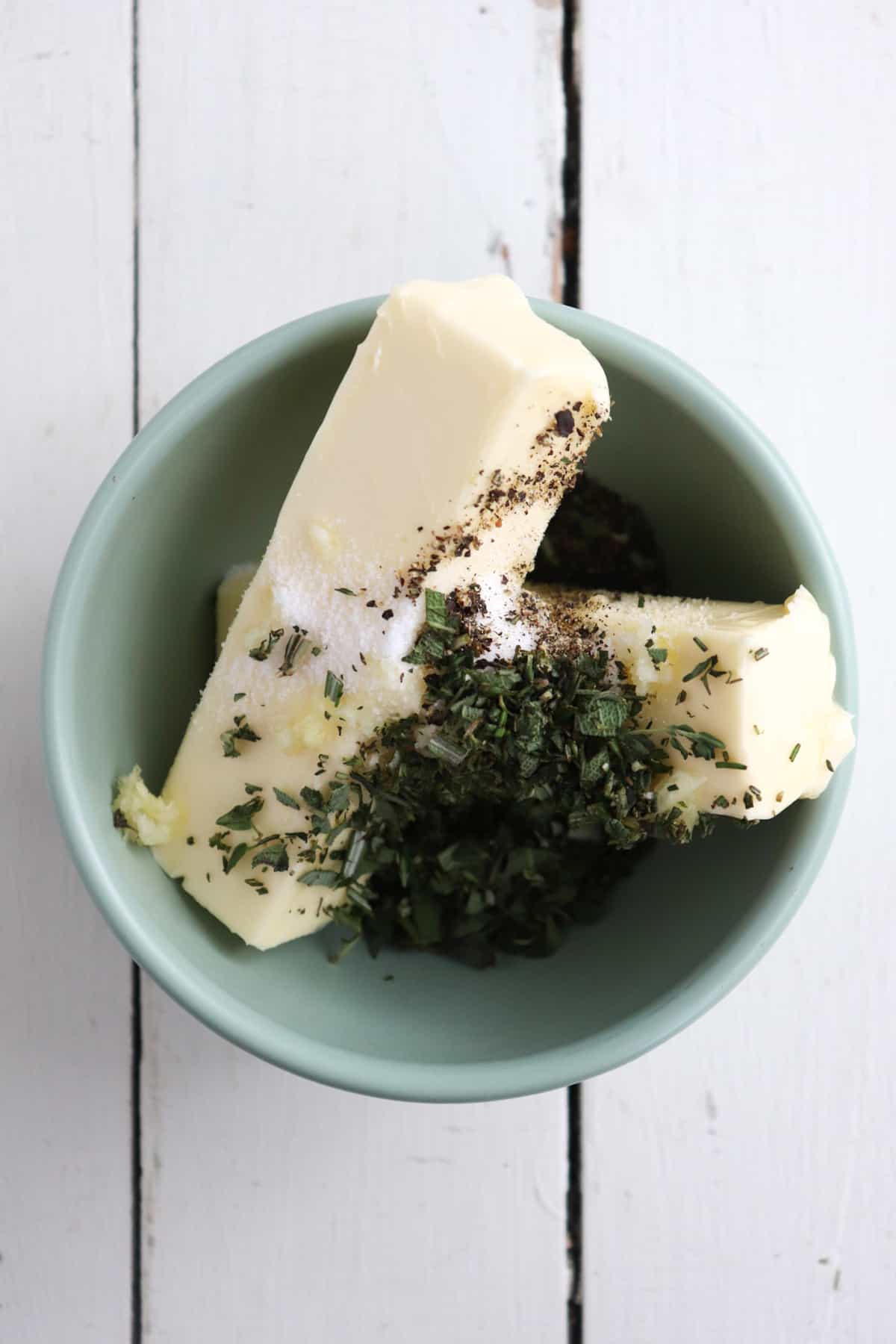
Step 1. Combine all of the compound butter ingredients, room temperature butter, fresh minced garlic, fresh herbs that have been finely chopped, olive oil, salt, and peppers.
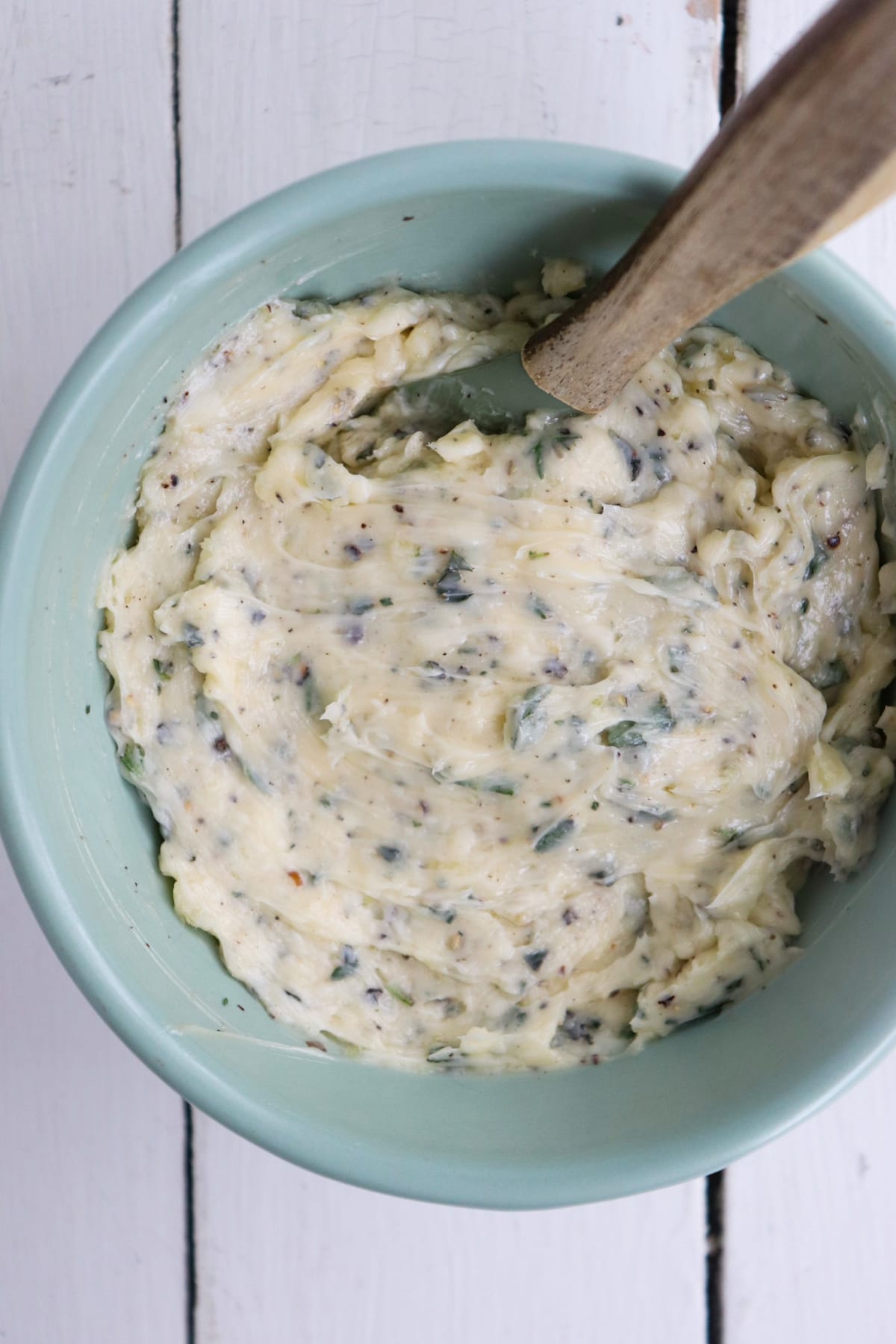
Step 2. Stir well so that all of the ingredients are fully incorporated into the butter.
Sarah Tip: It’s a great idea to prepare the compound butter the night before. Any prep you can do ahead of time, do it! Combine all the ingredients and then refrigerate. The morning of Thanksgiving, take the butter out and leave it on the counter so that it can come to room temperature.
How to Make the Turkey
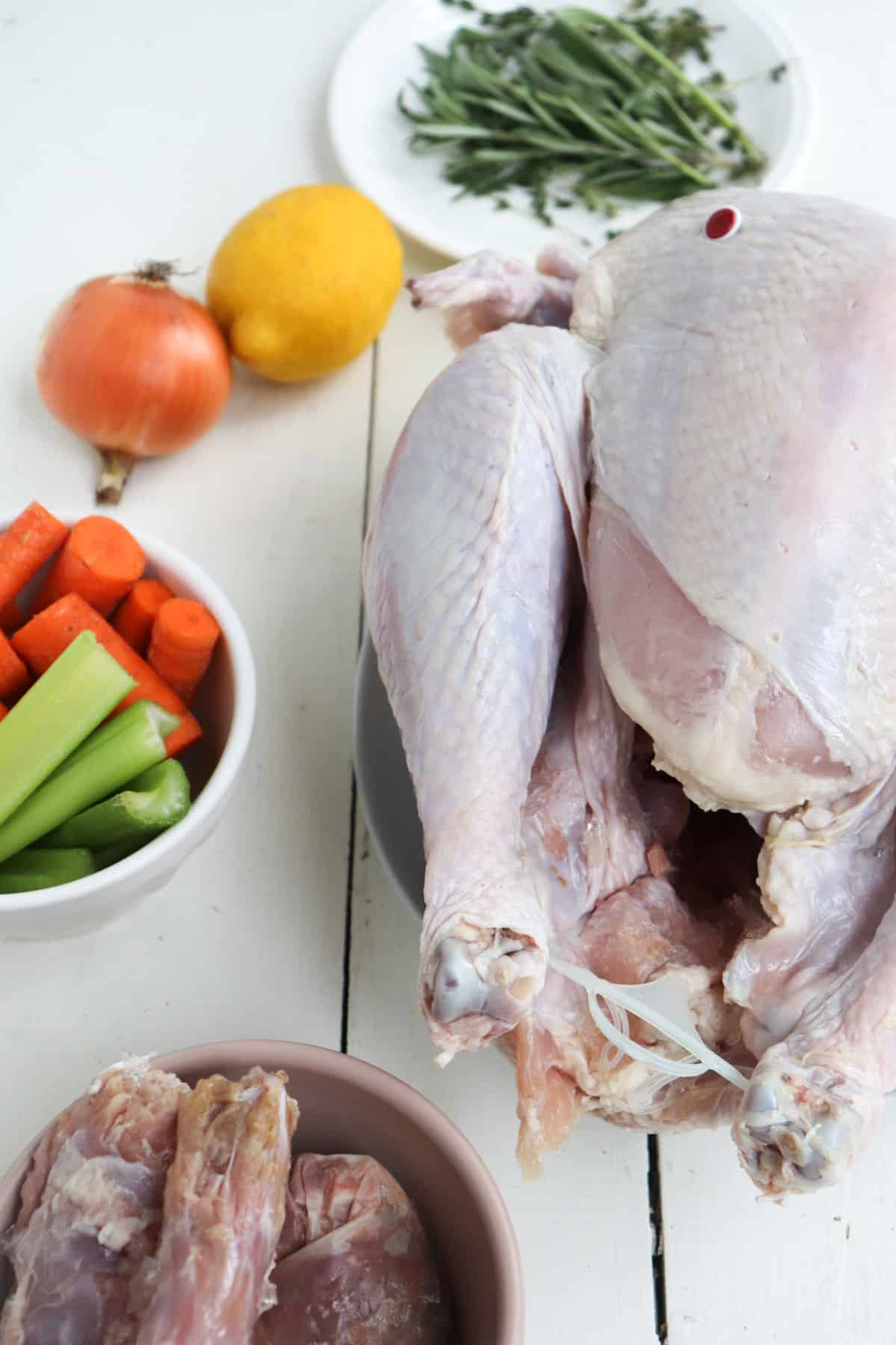
Step 1. Let the thawed turkey sit out for about a half hour before coating it in the butter mixture to let the skin dry out a bit (this will help its browning in the oven!).
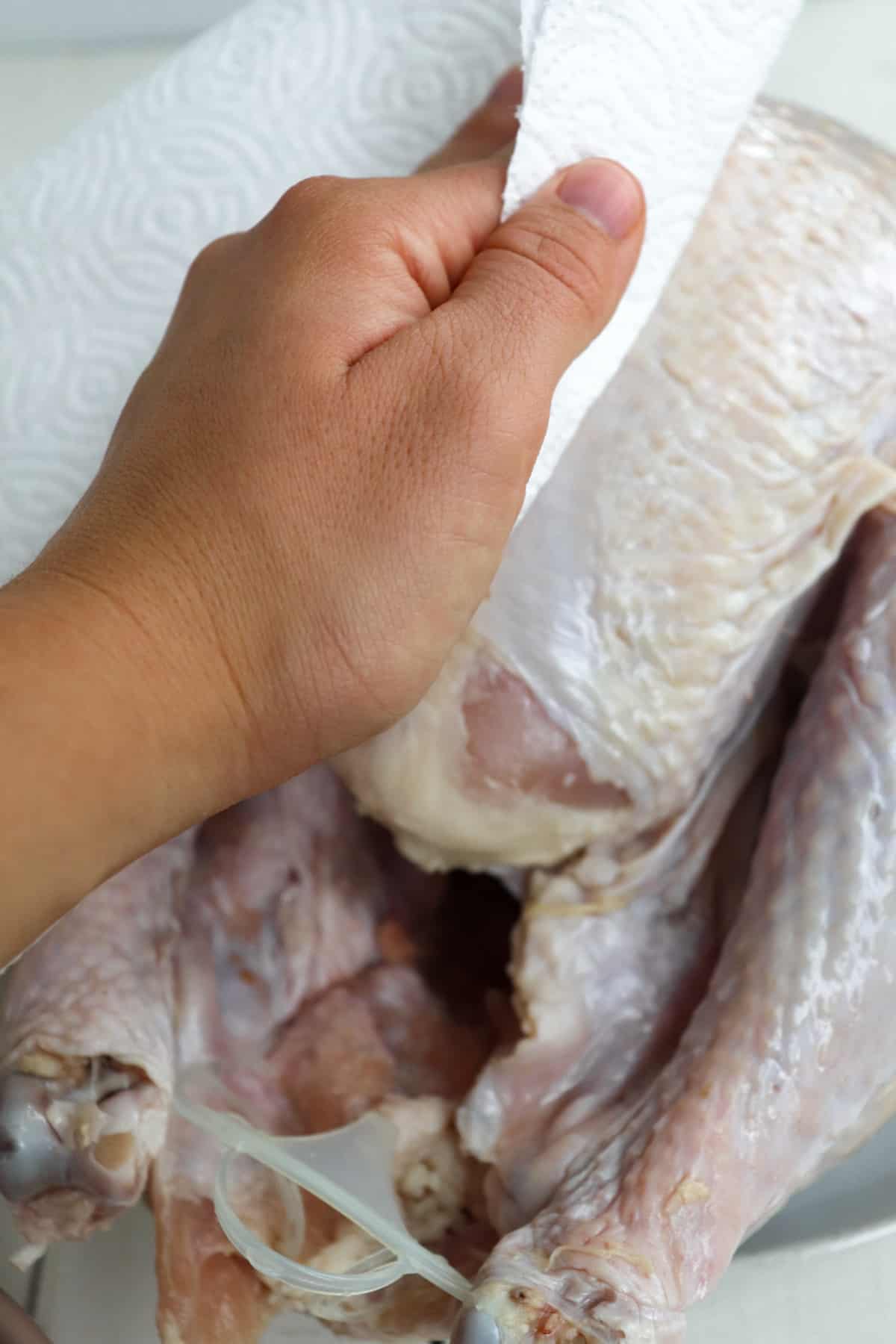
Step 2. To help it along a little bit, it’s totally okay to dab it with some paper towels.

Step 3. Stuff the turkey with your onions, lemon, and herbs. If there’s more than will fit in the cavity, just place the extras around the perimeter of the roasting pan.

Step 4. To get the butter under the skin of the turkey, the best way to go is to work your fingers gently in there to separate the skin from the muscle. You don’t want to completely pull it back, just keep working your hand (and depending on the size of your turkey, your arm), until it’s loose.
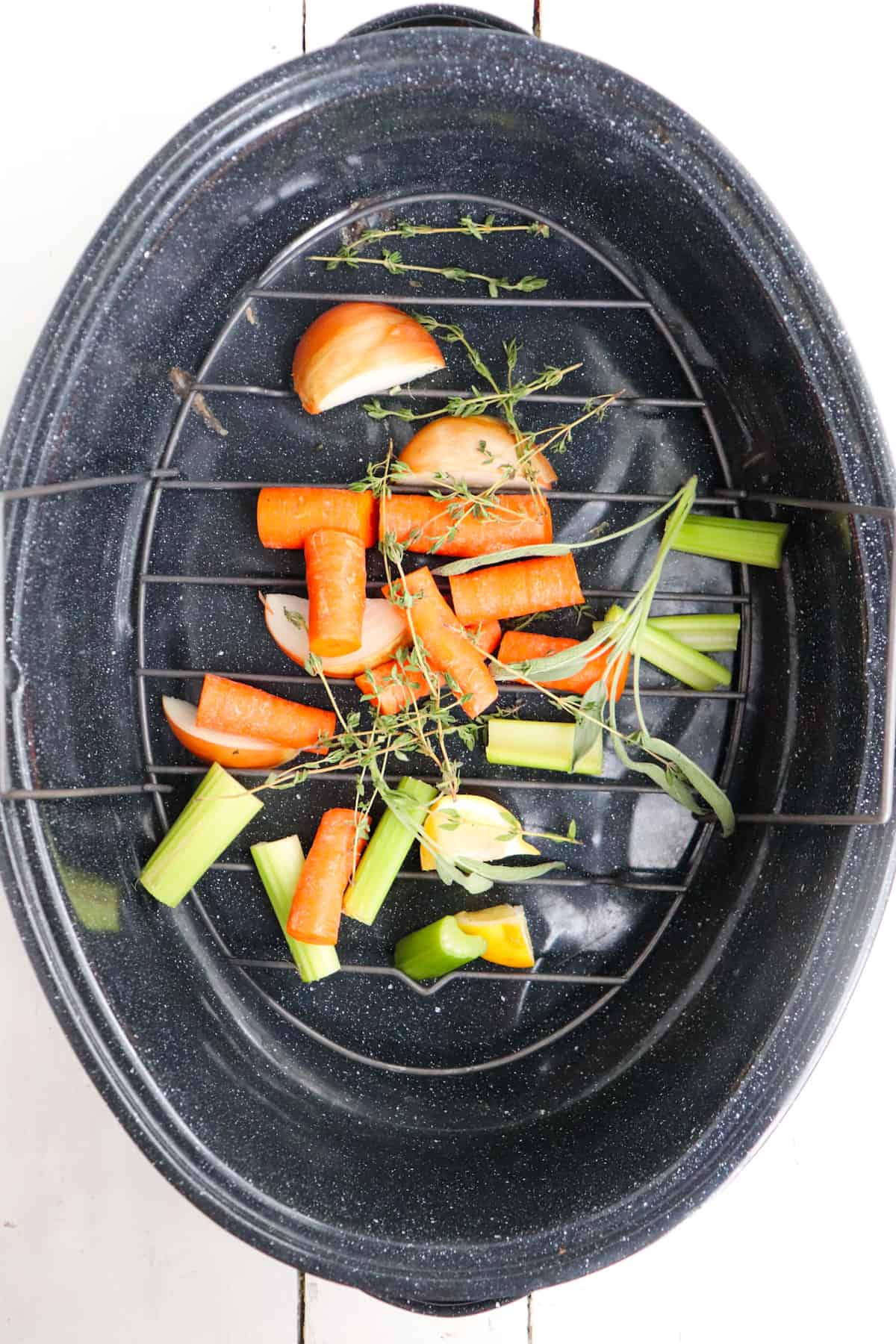
Step 5. Before you start rubbing the bird with butter (it will get slippery), tuck some carrots and celery underneath the turkey, either on top of the rack or in place of it. I also take this time to tuck the wings underneath the body of the turkey. You want the turkey to be as compact as possible for even cooking.

Step 6. Then go in there and add globs of the room temperature butter. You are going to want to get that butter everywhere! Under the skin, on top of the skin, and everywhere in between. It doesn’t have to be perfect, as it will melt in the oven, but you want the turkey to be as evenly and fully coated as possible. I like to put a little inside the cavity as well!

Step 7. Put the turkey in the oven at 325 F with the lid on or tented with tin foil. After 2 ½ hours, uncover the turkey and raise the heat to 375° F. Bake for another 1- 1 ½ hours until turkey is fully cooked through and a nice golden brown on the outside. It may start getting brown earlier than the inside is done, in which case just place your lid or tenting foil back on.
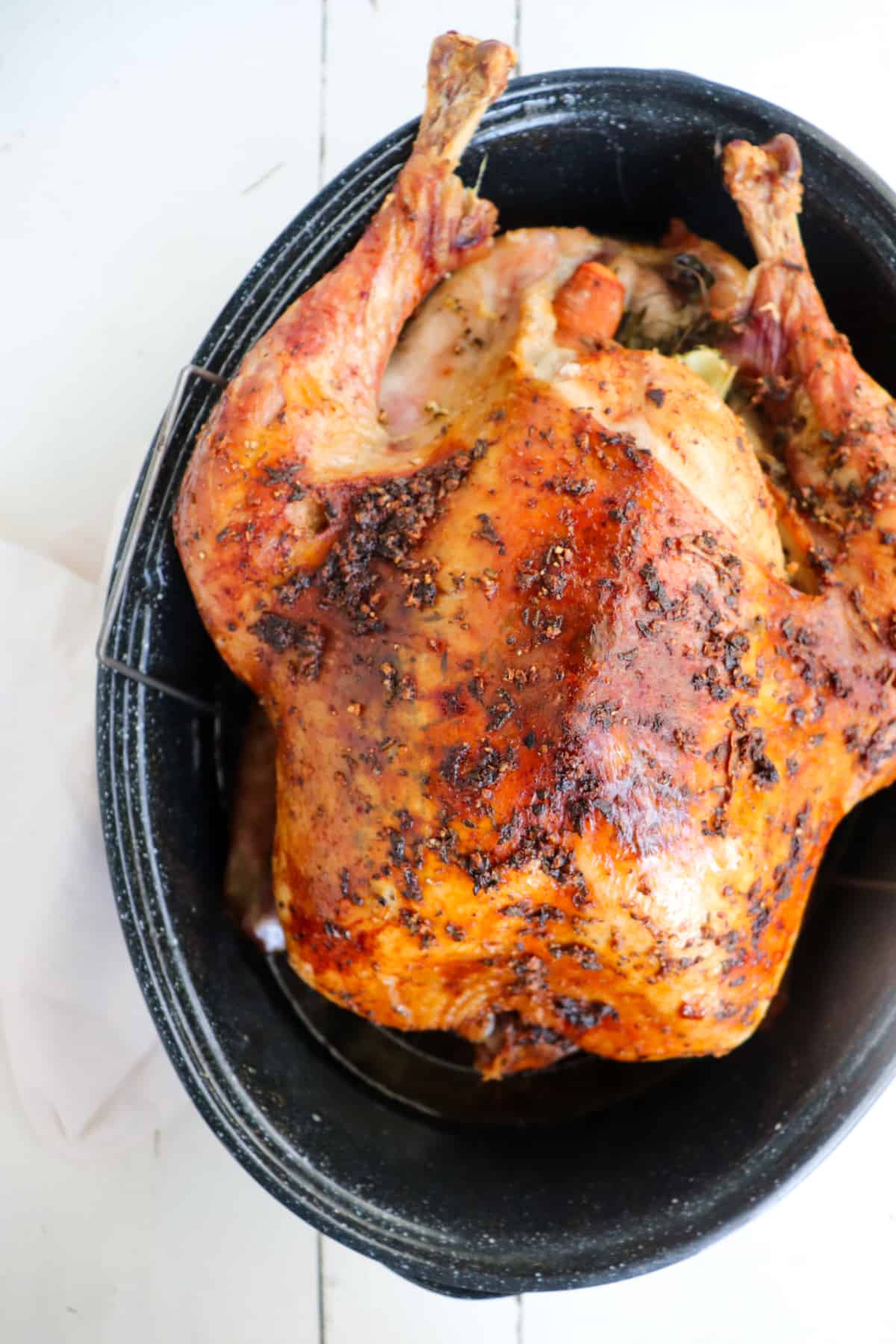
Step 8. Once the turkey reaches an internal temperature of 165 F (check it in several places with a meat thermometer), its done. Let turkey rest on the counter for 30 minutes after cooking to let all the juices redistribute. Then its carving time!
Stuffing the herb butter under the skin.
FAQ
What do you put under the skin of a turkey?
For the juiciest Thanksgiving Turkey, try rubbing a mixture of mayonnaise, butter, herbs and lemon zest all over and under the skin of the bird.
Is it worth putting butter under turkey skin?
Don’t butter your bird – Placing butter under the skin won’t make the meat juicier, though it might help the skin brown faster.Nov 23, 2015
What is the trick to crispy skin on turkey?
That trick is a sprinkling of baking powder, and it’ll get you the crispiest, crackliest bites of fatty, salty skin imaginable, whether you’re cooking just …
What do you put under turkey when cooking?
The butter and lemon slices under the skin baste the turkey and help keep it from drying out during its roast.
